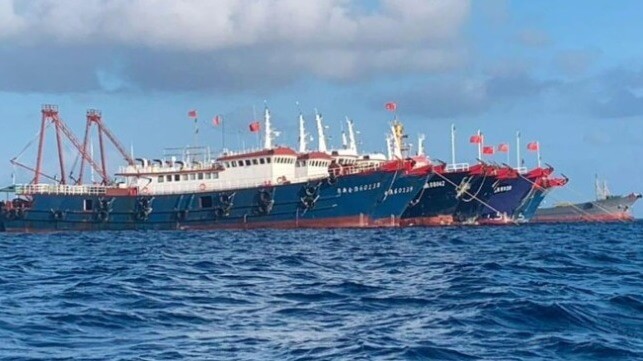How China's Maritime Militia Takes Advantage of the Gray Zone

[By Masaaki Yatsuzuka]
At the end of last year, Japan’s National Institute for Defense Studies released the 2023 edition of its annual China security report, which focuses on China’s quest for control of the cognitive domain and gray-zone situations. I, as one of the report’s authors, analyze how China uses its maritime militia and coastguard and what it aims to achieve.
In recent years, China has used paramilitary forces to put pressure on neighboring countries that have conflicting claims with Beijing. Japan has been one of the targets over which China seeks to gain dominance by deliberately creating gray-zone situations at sea. For example, in 2016, shortly after China’s then defense minister, Chang Wanquan, visited the maritime militia of Zhejiang, hundreds of Chinese fishing vessels swarmed into the waters surrounding the Senkaku Islands, which Japan effectively controls, and made repeated incursions into Japan’s territorial waters. Australia, too, has been a target. During Indo-Pacific Endeavour 2019, helicopters taking off from the Royal Australian Navy flagship HMAS Canberra were reportedly hit with lasers from Chinese fishing vessels.
There’s no conclusive evidence that China’s maritime militia were involved in these incidents. However, the Chinese government is clearly putting an emphasis on the militia to expand its maritime interests. Neighboring countries therefore need to accurately understand China’s intention in its use of maritime militias.
China’s maritime militia is under the direction of the Chinese Communist Party, the government and the military. The cadres of the local militia often hold positions in local governments and party organizations. For example, Wang Shumao, deputy commander of the maritime militia in Tanmen in Hainan province, who also serves as secretary of the CCP’s Tanmen branch, was elected as a delegate to the party’s 20th national congress. The maritime militia is not simply a group of fishermen; it is composed of personnel with various backgrounds, including fishery processors, shipbuilders, port builders, medical workers, veterans, local government officials and members of the CCP.
The Chinese maritime militia have a variety of missions, such as daily fishery production activities; maritime guerrilla operations; cooperation with and support for maritime operations forces; and engagement in gray-zone activities at sea.
The organizations with which the maritime militia collaborates are likely to vary depending on the situation. It coordinates with official government vessels for asserting maritime rights and interests in relatively low-intensity gray-zone areas, such as communications operations in disputed areas and surveillance of foreign fishing and research vessels. It also works with military organizations to conduct intelligence operations in gray-zone areas and interdiction activities against foreign military vessels, as well as relatively intense paramilitary operations, such as support and replenishment for the military in wartime and participation in military operations. The Chinese government may believe that mobilizing the maritime militia can control the escalation of a crisis, rein in the adversary, avoid military skirmishes and expand China’s effective control of certain areas.
Following Xi’s 2013 visit to a maritime militia force in Hainan province, the Chinese government stepped up its support for maritime militia units operating in the South China Sea. Government authorities provide fuel subsidies and subsidies for the construction and repair of fishing vessels operating in disputed waters. The number of vessels dedicated to maritime militia has increased significantly in recent years. Installation of the BeiDou satellite navigation system is well underway, with 70,000 Chinese fishing vessels equipped with the system as of 2020.
Beijing’s increasing control over the maritime militia will allow the central government’s intentions to be reflected at the grassroots. This may give two policy options to the Chinese government. Against a strong opponent, such as the US military, the maritime militia can be deployed to obstruct and check its actions and communicate China’s intentions while avoiding military escalation. For example, in the 2009 USNS Impeccable incident in the South China Sea, the Chinese side reportedly interfered with US operations not with its navy but by mobilizing nearby Chinese fishing boats.
On the other hand, if a small country is the adversary, the maritime militia can carry out extreme provocations to lure the adversary’s armed forces to take military action and justify its own military retaliation, which could result in heightening overall tensions. Indeed, in the so-called Battle of the Paracel Islands in January 1974, when China seized the islands from South Vietnam, which until then had effectively controlled and occupied them, Chinese fishing boats suspected to be part of the maritime militia repeatedly engaged in provocative behavior in the nearby waters even before military skirmishes began.
Which policy the Chinese government chooses will depend on its relationship with the opponent country. If it feels that inadvertent friction would be disadvantageous to it, it will not use the maritime militia to climb the escalation ladder. However, if it feels that using the maritime militia could expand China’s interests or deter the other side, it will be proactive in its use.
Masaaki Yatsuzuka is a senior fellow at Japan’s National Institute for Defense Studies and a visiting fellow at ASPI.
This article appears courtesy of ASPI's The Strategist and it may be found in its original form here.
The opinions expressed herein are the author's and not necessarily those of The Maritime Executive.
